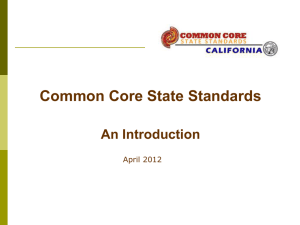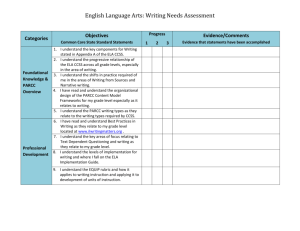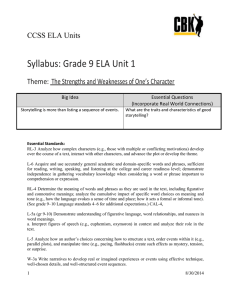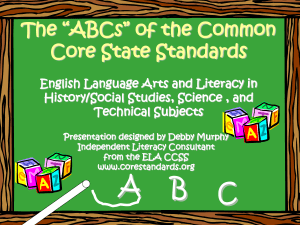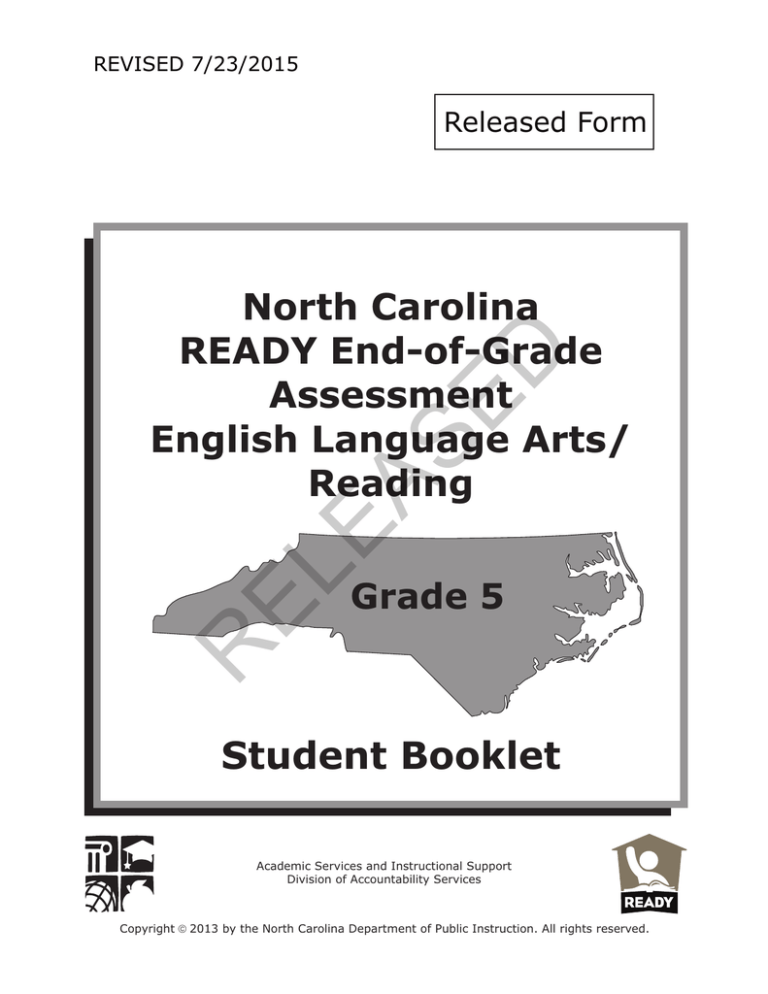
REVISED 7/23/2015
Released Form
EL
EA
SE
D
North Carolina
READY End-of-Grade
Assessment
English Language Arts/
Reading
R
Grade 5
Student Booklet
Academic Services and Instructional Support
Division of Accountability Services
Copyright ã 2013 by the North Carolina Department of Public Instruction. All rights reserved.
GRADE 5 ENGLISH LANGUAGE ARTS/READING—RELEASED FORM
Sample Questions
The Rhinoceros
by Oliver Herford
S2
A
calm
B
eager
C
scared
D
upset
EL
How does the Rhinoceros look at the beginning of the poem?
R
S1
Well, since he cares so much for style,
Let’s give him two and see him smile.
EA
10
SE
D
So this is the Rhinoceros!
I wonder why he looks so cross.
Perhaps he is annoyed a bit
Because his clothing does not fit.
5 (They say he got it ready made!)
It is not that, I am afraid.
He looks so cross because I drew
Him with one horn instead of two.
What would change the Rhinoceros’s feelings?
A
giving him new clothing
B
being afraid of his size
C
drawing him with two horns
D
showing off his new style
1
GRADE 5 ENGLISH LANGUAGE ARTS/READING—RELEASED FORM
Roberto and the Soccer Game
by Bernadine Beatie
D
Roberto stood close to the front of a long line of people waiting to buy tickets. Though
he had ridden all night on the small bus that traveled from his village to the city, he was
much too excited to be tired. Today Roberto’s dream would come true. At long last he
would see a soccer game between the two finest teams in Brazil! It hadn’t been easy.
First he’d had to persuade his parents that he was old enough to come alone; then he’d
had to earn the money. Roberto grinned and moved a step forward.
“Is it always so hard to get tickets?” Roberto asked the tall man next in line.
SE
“Not always. We are lucky to be so near the head of the line. Many behind us will be
turned away.” The man shrugged. “When Jorge Santos plays, everyone wants to see
him.”
EA
Roberto smiled. He had cut many pictures of Jorge Santos from newspapers.
“Someday,” Roberto said, “I am going to be a soccer player.”
EL
The man’s reply was lost in a burst of cheering. The street was suddenly filled with
young men and boys, shouting and laughing, running beside a long black car.
“Santos! Jorge Santos!” A great shout went up.
R
Roberto’s heart pounded. Jorge Santos sat, tall and proud, on the back seat of the car.
He was waving and smiling.
Roberto would have dashed forward to join the crowd, but the tall man caught his arm.
“Don’t lose your place. Soon the tickets will be gone.”
As Roberto stepped back into line, he saw that a shabbily dressed old man, leaning
heavily on a cane, was being swept along by the crowd.
“Careful!” Roberto called. But no one heard, and Roberto saw the old man stumble and
fall. Then the crowd surged forward, hiding him from view. Roberto forgot everything.
He left his place in line, squirmed through the crowd, and knelt beside the old man.
“Are you hurt, senhor—?” he asked.
The old man was red faced and angry. “Help me up! Fetch my cane!” he cried crossly.
2
Go to the next page.
GRADE 5 ENGLISH LANGUAGE ARTS/READING—RELEASED FORM
When Roberto obeyed, instead of thanking him, the old man glared at him. He raised his
cane and shook it at the crowd that followed Jorge Santos.
“Villains! Scoundrels!” he yelled. “Why don’t you look where you’re going?” He leaned
heavily on Roberto’s arm. “There’s a bench at the corner of the stadium,” he said. “Help
me to it.”
“But, senhor—” Roberto looked over his shoulder. The line waiting for tickets was even
longer now.
D
“You knocked me down,” the old man said impatiently. “The least you can do is take me
someplace where I can rest a moment and get my breath.”
SE
Roberto looked back again. He gave a little cry of dismay as the ticket window slammed
shut and a Sold Out sign flashed on. There were a few scattered boos, and the crowd
started moving away.
“What are you waiting for? Come along,” the old man ordered.
EL
EA
19
Roberto’s heart was in his stomach. He had given up his chance to see the game just to
help this cross old man. For a moment he thought of running away, of letting the old
man get to the bench the best way he could. Roberto shrugged. That would serve no
purpose now that the tickets were gone. And there was such a crowd about them that
he was afraid the man might fall again. So he walked slowly, keeping his shoulder high
to support the man.
R
The old man kept up a steady grumbling. “Young people! All they think about is games
and excitement. Think of the money they will waste today on foolishness.”
Roberto noticed again how shabbily he was dressed. He was probably cross because he
had no money. He might even be hungry.
“Here,” Roberto said, thrusting part of his money into the old man’s hand. “I don’t need
it now.”
There was a startled look on the man’s face. “I do not need your money,” he said
gruffly.
The crowd was so thick now that they had to pause. And over the heads of those
nearest to him, Roberto suddenly saw the tall man who had stood next to him in line.
3
Go to the next page.
GRADE 5 ENGLISH LANGUAGE ARTS/READING—RELEASED FORM
“I told you,” the man cried, “if you lost your place in line you would not get a ticket!”
Then the man was pushed along by the crowd.
“Ha!” said the old man. “So that is why you no longer need your money.” He laughed
softly. “You gave up your place in line to help me, and you have stayed with me even
though I have been cross and unreasonable. Why?”
Roberto searched for words.
“Never mind,” the old man said. “It is enough that you did it.” He chuckled softly.
“Come, follow me. You shall see the game.”
D
“But the tickets are all gone, senhor!” Roberto cried.
SE
“Nonsense!” exclaimed the old man, pushing Roberto toward the entrance of the
stadium. “Who needs tickets?”
EA
The old man must have lost his mind! Roberto tried to pull away, but the man propelled
him forward. And when they walked through the entrance to the stadium, Roberto could
hardly believe his eyes. The uniformed attendants bowed and smiled, clearing a way for
them. The next thing Roberto knew, the old man was steering him through a corridor
that led to the rooms where the players were waiting for the game to start.
EL
“Senhor Gomez!” rang out from all sides.
Roberto swallowed. “Ernesto Gomez?” he asked in a small voice.
R
34
“None other!” One of the players came over and gave the old man a hug. “And still
going around dressed like a pauper.”
Roberto gasped. The speaker was Jorge Santos! And Ernesto Gomez, this poor old man,
was the owner of Jorge’s team!
Senhor Gomez laughed. “This way I can find out what people really think of my team.”
He looked down at Roberto. “But today, had it not been for this one, I would have been
trampled on the street. He gave up his chance to get a ticket so that he could help me.”
“You shall have the best seat in the house.” Jorge grinned down at Roberto. “You shall
sit on the bench beside us.”
Roberto’s heart was so full he couldn’t speak. He smiled shyly at Jorge and at Senhor
4
Go to the next page.
GRADE 5 ENGLISH LANGUAGE ARTS/READING—RELEASED FORM
Gomez. It was not every day that dreams come true!
2
A
Generous acts are rewarded.
B
Accept others’ differences.
C
Be unafraid to try new things.
D
Do not be upset by past mistakes.
D
Which statement summarizes the theme of the selection?
SE
1
In the sentence below, what does the word shabbily mean?
B
fancy
C
poorly
D
trendy
EL
costly
R
3
A
EA
“Roberto noticed again how shabbily he was dressed.”
Which event in the story caused the old man to fall down?
A
The soccer team won the game and rushed onto the streets.
B
The soccer game was canceled, and the fans were angry.
C
The soccer player rode by, and people ran over to see him.
D
The soccer stadium sold all of the tickets and closed the gate.
5
Go to the next page.
GRADE 5 ENGLISH LANGUAGE ARTS/READING—RELEASED FORM
He was disappointed about not getting tickets for the soccer game.
B
He was concerned that the old man had gotten hurt from the fall.
C
He was frustrated that the old man was pushed down by the crowd.
D
He was excited to see Jorge Santos in the back of the car waving and
smiling.
wearing old and worn clothes
B
wearing new or fancy clothes
C
wearing summer clothes
D
wearing tight clothes
SE
A
D
In paragraph 34, what is the meaning of “dressed like a pauper”?
EA
6
A
Based on the selection, how did Roberto get to see the game?
EL
5
In paragraph 19, what is the meaning of “Roberto’s heart was in his stomach”?
A
He walked in with the players on Jorge’s team.
B
He was let into the stadium with the owner of Jorge’s team.
C
He bought a ticket after helping the old man.
D
He came in with the tall man that stood in line.
R
4
6
Go to the next page.
GRADE 5 ENGLISH LANGUAGE ARTS/READING—RELEASED FORM
In the selection, what can be inferred about how the people in the crowd viewed
the old man?
A
The crowd did not know that the old man was the owner of the soccer team,
so they pushed him down.
B
The crowd was upset that the gate was late opening, so they pushed the old
man down.
C
The crowd was upset that the tickets were sold out, so they pushed the old
man down.
D
The crowd did not want the old man to get tickets before them, so they
pushed him down.
upset
B
proud
C
embarrassed
D
grateful
EL
A
EA
Which word describes how Roberto felt toward the old man at the end of the
selection?
R
8
SE
D
7
7
Go to the next page.
GRADE 5 ENGLISH LANGUAGE ARTS/READING—RELEASED FORM
From the pages of TIME for Kids. This article was written in 2010.
Will You Drive an Electric Car One Day?
by Brian Dumaine
Coming this fall, electric cars will be hitting the road in the United States. The cars may
help Americans kick the oil habit one day.
SE
D
Soon, electric cars may be whirring through your neighborhood. These quiet, clean,
battery-powered vehicles can be charged in a wall outlet, like a giant power tool. This
fall, General Motors (GM) is launching its electric Volt. The car runs on electricity, but it
also has a gas engine. Nissan will begin selling its all-electric Leaf, a compact car that
will average 100 miles on a charge. Other carmakers will start selling electric models in
2011.
EA
Automakers say that the world’s population is slated to jump from 6.8 billion to 9 billion
by 2050. So the supply of oil (which is turned into gasoline) won’t keep up with the
number of cars on the road. Tony Posawatz is in charge of GM’s Volt project. He says,
“Everyone agrees we have to get off of oil. In 10 years, the number of cars around the
globe will rise from 800 million to 1.1 billion. We know the price of oil will go up.”
EL
CHARGE IT
R
4
To help car companies develop oil-free electric vehicles, the U.S. government has given
billions of dollars to makers of electric cars. But huge roadblocks remain. It can take as
much as eight hours to charge a car for only 100 miles of driving. And the distance the
car can go changes depending on driving conditions. According to Nissan, the Leaf has a
100-mile range—on cool, sunny days and on flat roads. On a hot day in heavy traffic, its
range drops to 47 miles.
Price is a problem too. Electric models cost much more than similar gasoline-powered
cars. The good news is that electric-car technology is improving, and the prices of the
vehicles are dropping as it does.
Where will drivers be able to charge the cars? The U.S. Department of Energy is giving
grants to pay for at least 10,000 charging stations around the nation.
GEARING UP
Private businesses are also gearing up. Richard Lowenthal is the head of Coulomb
8
Go to the next page.
GRADE 5 ENGLISH LANGUAGE ARTS/READING—RELEASED FORM
Technologies, a company in California. He says that his firm will install about
4,500 charging stations, mostly at office parks and homes. The stations are rectangular
boxes about the size of a parking meter. Each has a plug and cord. The cost? About
$3 per charge. “The typical car is parked 23 hours a day. You can charge it while you
work and while you sleep,” Lowenthal says.
TIME for Kids and the TIME for Kids logo are registered trademarks of Time Inc. used under license.
Electric cars are cheaper to buy than gasoline-powered cars, and they can
only go for 100 miles before recharging.
B
Nissan will sell more gasoline-powered cars, and other car companies will
stop making battery-powered cars in the future.
C
Electric cars have some limitations, and the U.S. government sees electric
cars as a solution to the oil supply problem.
D
Tony Posawatz estimates that the price of oil will go up in the future due to
population increases, and fewer vehicles will be on the road.
EA
SE
D
A
In the sentence below, what is the meaning of the phrase “kick the oil habit”?
EL
10
What are the main ideas supported by the selection?
“The cars may help Americans kick the oil habit one day.”
A
get to use more oil
B
turn oil into gasoline
C
stop using so much oil
D
use oil only for important things
R
9
9
Go to the next page.
GRADE 5 ENGLISH LANGUAGE ARTS/READING—RELEASED FORM
to tell how popular the electric car will be in the future
B
to show that the increase in population does not matter
C
to explain that the population is not going to change
D
to describe the importance of reducing the demand for gas
D
What is the reason for the section titled “Charge It” in the selection?
to tell how much gasoline cars use
B
to explain challenges faced by electric cars
C
to state how cheap it can be to charge an electric car
D
to give a clear picture of what an electric car looks like
SE
A
EA
13
A
Based on the selection, why did the U.S. government give “billions of dollars to
makers of electric cars” for development?
EL
12
According to the selection, why does the author include information about the
world’s population today as compared to 2050?
A
The use of gas-powered cars does not save the U.S. money like electric cars
do.
B
The use of gas-powered cars is causing pollution to remain in our
atmosphere.
C
The world’s population is declining, so gas-powered cars may not be
needed in the future.
D
The world’s population is growing faster than the supply of available oil.
R
11
10
Go to the next page.
GRADE 5 ENGLISH LANGUAGE ARTS/READING—RELEASED FORM
14
In paragraph 4, what is the meaning of the sentence below?
“But huge roadblocks remain.”
B
Electric cars break down easily and may block traffic on roads.
C
Electric cars may solve the U.S. government’s oil supply problem.
D
Electric cars and gasoline-powered cars will cause traffic problems.
D
Electric cars have some issues that need to be resolved.
Why did the author end the selection with the quote below?
SE
“ ‘The typical car is parked 23 hours a day. You can charge it while you work and
while you sleep,’ Lowenthal says.”
to tell the reader that people lose a lot of good driving time
B
to give the reader technical information about vehicles
C
to show that electric cars are easy to charge and maintain
D
to persuade the reader to buy charging stations
EL
EA
A
R
15
A
11
Go to the next page.
GRADE 5 ENGLISH LANGUAGE ARTS/READING—RELEASED FORM
Song
by Amy Lowell
D
Oh! To be a flower
Nodding in the sun,
Bending, then upspringing
As the breezes run;
5 Holding up
A scent-brimmed cup,
Full of summer’s fragrance to the summer sun.
EA
SE
Oh! To be a butterfly
Still, upon a flower,
10 Winking with its painted wings,
Happy in the hour.
Blossoms hold
Mines of gold
Deep within the farthest heart of each chaliced* flower.
Oh! To be a cloud
Blowing through the blue,
Shadowing the mountains,
Rushing loudly through
Valleys deep
20 Where torrents keep
Always their plunging thunder and their misty arch of blue.
R
EL
15
Oh! To be a wave
Splintering on the sand,
Drawing back, but leaving
25
Lingeringly the land.
Rainbow light
Flashes bright
Telling tales of coral caves half hid in yellow sand.
Soon they die, the flowers;
*
chaliced: cupped
12
Go to the next page.
GRADE 5 ENGLISH LANGUAGE ARTS/READING—RELEASED FORM
30
Insects live a day;
Clouds dissolve in showers;
Only waves at play
Last forever.
Shall endeavor
35
Make a sea of purpose mightier than we dream today?
18
D
“Bending, then upspringing / As the breezes run;”
B
“Drawing back, but leaving / Lingeringly the land.”
C
“Rainbow light / Flashes bright”
D
“Only waves at play / Last forever.”
EA
SE
A
Which describes the speaker’s point of view about being a butterfly?
A
She would feel useless.
B
She would feel nervous.
C
She would feel important.
D
She would feel carefree.
EL
17
Which lines help explain the main idea of the poem?
R
16
In the second stanza, what does the speaker call “Mines of gold”?
A
nectar from the flowers
B
colors of the flowers
C
height of the flowers
D
smell of the flowers
13
Go to the next page.
GRADE 5 ENGLISH LANGUAGE ARTS/READING—RELEASED FORM
stories of rainbows in the sky
B
tales of coral caves
C
flashes of bright light
D
drawings of a butterfly
D
According to the poem, how are flowers and butterflies alike?
Both are happy.
B
Both are beautiful.
C
Both grow only in the summer.
D
Both live only a short time.
SE
A
EA
21
A
According to the poem, how is a cloud’s fate different from the flowers’ and
butterflies’ fate?
EL
20
In the fourth stanza, what do the waves reveal hidden in the sand?
A
It goes away, while they come back again.
B
It only lives for a day, while they last forever.
C
It dissolves in the rain, while they die.
D
It floats out to sea, while they stay on land.
R
19
14
Go to the next page.
GRADE 5 ENGLISH LANGUAGE ARTS/READING—RELEASED FORM
Based on the last stanza, what is the speaker’s favorite thing in nature?
waves
B
clouds
C
flowers
D
insects
EL
EA
SE
D
A
R
22
15
Go to the next page.
GRADE 5 ENGLISH LANGUAGE ARTS/READING—RELEASED FORM
Plier Jaws and Sipper Tongues
Insects, arachnids, and other many-legged animals don’t have the kind of mouth we do.
Their mouth is just an open hole.
D
2
Insects have special parts around their mouth, to help them eat. The kind of mouthparts
an insect has depends on the way the insect eats. Some insects, such as ants and
dragonflies, chew their food. These insects have two strong jaws that stick out on each
side of the mouth. These jaws work like a pair of pliers. With them, the insect tears off
pieces of food, such as bits of a leaf.
SE
3
The inner edges of the jaws are lined with little teeth that can grind and cut. The jaws
work sideways, not up and down as yours do. If you could hear an insect chewing a bit
of leaf, it would sound much like a person chewing celery!
EL
EA
4
Actually, chewing insects have two sets of jaws. Behind the chewing jaws there is
another set of jaws. These jaws are somewhat like fingers. They reach out and take the
chewed-up food from the front jaws. Then, the jaws curl back and push the food into the
animal’s mouth.
R
5
Many kinds of insects drink their food. They eat only liquids. So, their mouthparts are
made for sipping. A butterfly has a long tube that comes out of its mouth. The tube is
coiled up most of the time. But when the butterfly smells nectar, the tube uncoils. Then
it is a sipper, like a soda straw.
6
A mosquito’s lower lip forms a long beak with a groove in it. Six sharp “needles” stick
out from the end of the beak. The mosquito jabs the needles into the skin of an animal
or person, causing blood to flow. Then it sucks up the blood through the groove in its
beak. Some kinds of insects suck juice from plants in the same way.
A housefly’s lower lip forms a tube with a pair of thick pads on the end. The housefly
sops up liquid with the pads and sucks the liquid up into its mouth. It can also turn some
things, such as sugar, into liquid, so it can eat them. To do this, it lets “spit” ooze out of
its mouth onto the food. This “spit” turns the solid food into a liquid.
16
Go to the next page.
GRADE 5 ENGLISH LANGUAGE ARTS/READING—RELEASED FORM
Spiders turn all of their food into liquid. They have a pair of curved, hollow claws just
above the mouth. When they grab their prey, they shoot poison through these hollow
claws. The poison turns the inside of the prey’s body into a liquid. The spider then sucks
in the food through a mouth tube.
Some kinds of spiders use their claws to crush their prey. Then they dissolve the prey by
spraying liquid on it. The spider then sucks the food in up through its mouth tube.
D
Insect jaws help objects turn.
B
Insect jaws grip objects tightly.
C
Insect jaws hold objects loosely.
D
Insect jaws knock objects into place.
EA
SE
A
In paragraph 3, what is the significance of comparing an insect chewing a leaf to a
person chewing celery?
EL
24
In paragraph 2, what is meant by “These jaws work like a pair of pliers”?
A
to help the reader imagine the chewing sounds of insects
B
to help the reader understand how insect food tastes
C
to help the reader learn about spiders and insects
D
to help the reader visualize how insects find their food
R
23
17
Go to the next page.
GRADE 5 ENGLISH LANGUAGE ARTS/READING—RELEASED FORM
27
Houseflies drink their food, and they use little teeth to tear off pieces of
food.
B
Insects chew their food, and they use their jaws to push food into their
mouth.
C
Mosquitoes dissolve their food, and they use a needle beak to suck up food.
D
Spiders crush their food, and they use their claws like fingers to pick up
food.
D
A
straightened
B
piled
C
twisted
D
rolled
EA
A
SE
In paragraph 5, what is the meaning of coiled?
EL
26
What are the main ideas of paragraph 4?
How are butterflies and mosquitoes similar?
A
They have long tubes.
B
They have another set of jaws.
C
They use grooves to eat.
D
They eat only liquids.
R
25
18
Go to the next page.
GRADE 5 ENGLISH LANGUAGE ARTS/READING—RELEASED FORM
Dragonflies and spiders spit onto solid food before eating.
B
Ants and spiders dissolve food by using a liquid spray.
C
Houseflies and spiders turn solid food into a liquid food.
D
Mosquitoes and spiders use needles to jab into prey.
sticks
B
sucks
C
chews
D
coils
SE
A
D
What is the meaning of jabs in paragraph 6?
EA
30
A
Which step completes the graphic organizer?
Spiders grab
their prey.
EL
29
Which statement shows a way some insects are similar to spiders?
Spiders shoot
poison into
their prey.
Spiders
suck up food
through their
mouth tubes.
?
R
28
A
The spider jabs needles into the prey’s skin.
B
The spider sprays liquid on the prey’s body.
C
The inside of the prey’s body turns to liquid.
D
The blood of the prey is absorbed with thick pads.
19
Go to the next page.
GRADE 5 ENGLISH LANGUAGE ARTS/READING—RELEASED FORM
Trade Rats
by Ethel Twycross Foster
The little clock struck twelve; all were sleeping soundly, the tent flap was rolled away,
and a streak of moonlight stretched half across the floor.
D
Mary and her mother lay on a bunk, and beyond the partition one could hear the even
breathing of father and cousin Jack. All else was still save the occasional cry of a night
hawk or the far distant call of a coyote.
SE
3
Slowly, cautiously, stealthily into this silence crept a tiny object. Its sharp black eyes
flashed fire in the moonlight, and in its small mouth it carefully carried a cactus burr.
EA
“Pst! Mary, did you hear something?” It was cousin Jack’s hoarse whisper that broke the
silence and awakened Mary from a beautiful dream, and her eyes popped open wide.
She snuggled closer to Mother and stared into the moonlight. All she could hear was a
funny little scratching sound unlike any she had ever heard around camp, and she knew
not what it meant. None of her little animal friends made a noise like that.
R
EL
Jack was out of bed, had lighted a candle and, in his pajamas, was searching under
bunks, tables, and chairs for the thing that had caused the noise. Mary sat up in bed in
time to hear a swift, rustling sound and see a small object dart out of the tent door. Jack
knew it would do no good to search outside, so he tumbled back into bed and once more
all was still.
6
The next morning at breakfast all were wondering who the strange visitor could have
been, but soon the incident was forgotten. Toward noon, Mary went to a vacant bunk
where she kept her clothes and picked up her new doll. She removed its dress and
looked about for a little red wool gown, of which she was very fond, for the day was
chilly and it looked like rain. But the gown was gone; high and low she looked, but find it
she could not. At last, tired out with searching, she fell asleep, and the pretty lost gown
remained a mystery.
During the next few days strange things happened. On the day following, one of Dolly’s
stockings was gone; on the next, its mate; on the next, a pretty little velvet bonnet, and
so on for a week. The strangest part of it was that something or somebody was bringing
in little sticks of wood and cactus burrs and piling them up among the doll clothes.
20
Go to the next page.
GRADE 5 ENGLISH LANGUAGE ARTS/READING—RELEASED FORM
At the end of the week, Jack decided to solve the mystery. He said he was going to sit
up all night and see what kind of a thing was coming into the tent so regularly. He didn’t
do exactly what he intended to do, for by ten o’clock his eyelids grew too heavy and he
was fast asleep in the vacant bunk which he had chosen for a hiding place.
SE
D
9
Patter, patter, patter; something was coming. Jack awoke with a start of expectation.
There was no moon tonight, but he had left a candle burning in a distant corner. It was
all he could do to keep back a chuckle when he saw a big gray rat dart across the floor
with a good-sized twig in its mouth. Jack kept perfectly still, and the little fellow, not
even seeing him, continued its way across the floor to the bunk on which sat Jack beside
the doll clothes. It clawed its way up the side of the bunk, dropped the twig, then
selected a soft, woolly skirt. Then it turned and scampered away through the door and
out into the sagebrush.
Jack gave a hearty laugh, and at once awakened the whole family and told them his
story.
EA
“Of course,” said Father, “it was a trade rat. Why didn’t we think of that before? The hills
are full of tiny holes where they burrow down and build their nests.”
“But what about the twig?” asked Jack.
EL
“They always pay for what they take,” was the unexpected reply. “They are great fellows
to steal both food and clothing, but they never take anything without replacing it with a
cactus burr, a twig, a chip of wood, or something of the sort. They seem to think it
wrong not to leave something in place of what they take.”
R
“But what did they do with all my dolly’s clothes?” asked Mary. “Surely they can’t wear
them.”
“Indeed no, my dear little girl,” said Father, “but probably if you could find their nest,
you would see them busy at work lining it with the soft, downy cloth in preparation for a
family of little ones.”
Mary talked and wondered about all these happenings, and you can imagine her delight
when big Joe came running up to camp one day and told her he had found her rat’s
nest. The men had been digging on a little hill preparing to build the foundation of an
extra tent. The hill was covered with rat holes and gopher holes, and Joe lifted up a
shovel full of adobe and underneath was a little cave all carefully lined with warm
clothing. On the soft bed lay mother rat and six tiny little fellows with eyes just opened.
21
Go to the next page.
GRADE 5 ENGLISH LANGUAGE ARTS/READING—RELEASED FORM
They were peering around with a frightened look and giving shrill little squeaks of
dismay.
33
Trade rats always take food and clothing, but never leave items.
B
It is difficult to stay awake late at night when trying to solve a mystery
about trade rats.
C
With help from Mary, Jack discovers a rat’s nest made with items that were
taken from their camp.
D
A mystery is solved when trade rats are found exchanging items for warm
clothing to line their nest.
EA
SE
D
A
As used in paragraph 3, what is the meaning of the word stealthily?
A
with little sound
B
with little thought
C
with some assistance
D
with much confusion
EL
32
Which statement summarizes the selection?
R
31
In paragraph 6, what is the meaning of the word vacant?
A
busy
B
complete
C
empty
D
full
22
Go to the next page.
GRADE 5 ENGLISH LANGUAGE ARTS/READING—RELEASED FORM
It was muddy outside.
B
It was cloudy outside.
C
It was flooding outside.
D
It was lightning outside.
annoyed
B
interested
C
startled
D
worried
SE
A
D
Based on the selection, how does Jack feel about the night thief?
EA
36
A
What is the meaning of the word scampered as used in the sentence below from
paragraph 9?
EL
35
In paragraph 6, what is meant by “it looked like rain”?
“Then it turned and scampered away through the door and out into the
sagebrush.”
A
opened
B
strolled
C
lifted
D
hurried
R
34
23
Go to the next page.
GRADE 5 ENGLISH LANGUAGE ARTS/READING—RELEASED FORM
What is the effect of Jack’s reaction to the missing doll clothes?
He decides to search outside for the visitor.
B
He decides to cover all the holes on the hill.
C
He discovers who the strange visitor was.
D
He discovers the hidden nest.
EL
EA
SE
D
A
R
37
24
Go to the next page.
GRADE 5 ENGLISH LANGUAGE ARTS/READING—RELEASED FORM
Dynamic Duo
by Melissa DeRosa and Amanda DeRosa
D
We are Melissa and Amanda, and we’re 13-year-old mirror-image twins. Imagine your
reflection in the mirror being real. That’s us. Often, even the internal organs of
mirror-image twins are in reversed positions. It’s a very rare kind of identical twins.
Although we don’t have inverted organs, Melissa has a bigger tonsil on the right and
Amanda on the left, our teeth grew in the same order but on opposite sides of our
mouths, our hair whirls grew in opposite directions, and our parents report that they can
walk into our rooms any hour of the night and find us sleeping in the same position, only
mirrored.
EL
EA
SE
2
Like many twins, we can feel each other’s pain. It might sound weird, but it’s true. When
we went for our first shots as babies, one of us got a shot, and the other one jerked her
leg and cried at the same time. Melissa fell off a swing and sprained her ankle in second
grade, and Amanda started limping on the way back to class. At summer camp, Amanda
hit her left thumb with a hammer and went to the nurse for ice. A few minutes later,
Melissa arrived at the nurse’s office asking for ice because she hit her left thumb with a
hammer. The nurse said, “I just gave you ice!” Melissa didn’t know what she was talking
about.
R
3
In conversation, we finish each other’s sentences. If one of us is thinking something, the
other one blabs it out. We used twin language briefly as toddlers. That’s when a set of
twins use special words that they invented and only they understand.
4
We keep in touch with other twins, and they’ve also had some weird experiences. One
time, twins we know went shopping and came out of the mall with the same outfit,
unaware of what the other one was buying. This same set of twins exchanged birthday
cards and gifts, only to find that they’d picked the same card and used the same
wrapping paper. Another time, a twin we know went to call her sister, and instead of
getting a dial tone, she got her sister who was calling her at the same time. These twins
also planned to surprise each other with lunch at work, but missed each other because
each sister was on her way to surprise the other one.
5
Though we do have many connections, we also have some interesting differences.
25
Go to the next page.
GRADE 5 ENGLISH LANGUAGE ARTS/READING—RELEASED FORM
Amanda is better at math, while Melissa is better at writing essays. One of us is more
creative, and the other is neater. We take turns being bossy, shy, and messy. Our
parents say it’s like a marriage; we have to take turns being the boss so we can live
together without killing each other.
There are all kinds of twin mysteries that scientists, psychologists, and researchers are
still trying to figure out. It’s a unique connection, and we surprise ourselves sometimes,
too!
D
Twins always like the same things.
B
Many twins shop on the same days.
C
Most twins are not mirror images of each other.
D
Twins have interesting sleeping habits.
EA
SE
A
Based on paragraph 3, what is “twin language”?
EL
39
Which statement is supported by the selection?
A
a language of hand signs and gestures
B
a language invented and used between twins
C
a language of both spoken and written words
D
a language spoken by only young children
R
38
26
Go to the next page.
GRADE 5 ENGLISH LANGUAGE ARTS/READING—RELEASED FORM
B
Twins look exactly alike, and they always finish each other’s sentences.
C
Twins buy similar outfits to dress alike, and they only talk to each other in
twin language.
D
Twins usually think alike, and they can feel each other’s pain.
D
Twins have problems because they are so alike, and they can never surprise
each other.
As used in paragraph 5, what does the word connections mean?
organs that are linked together
B
voices that imitate other people
C
powerful influences on twins
D
similarities in looks and actions
SE
A
EA
42
A
In paragraph 5, what did the parents’ figurative language describe?
EL
41
What are the main ideas of paragraphs 2 and 4?
A
The twins are together forever.
B
The twins must promise to love one another.
C
The twins must take turns being in charge.
D
The twins are around each other most of the time.
R
40
27
Go to the next page.
GRADE 5 ENGLISH LANGUAGE ARTS/READING—RELEASED FORM
A
Twins have been studied and are well understood by scientists.
B
New information about twins is still being discovered through research.
C
Research about the mysteries of twin connections is finished.
D
Twins know more about themselves than most scientists do.
D
Why is the twin relationship referred to as a “unique connection” in the selection?
There is nothing like it.
B
Everyone understands it.
C
Scientists first discovered it.
D
Parents are unable to explain it.
EA
SE
A
EL
44
What do the authors suggest in the last paragraph?
R
43
28
Go to the next page.
GRADE 5 ENGLISH LANGUAGE ARTS/READING—RELEASED FORM
This is the end of the English Language Arts/Reading test.
Directions:
1. Look back over your answers for the test questions.
2. Put all of your papers inside your test book and close your test book.
R
EL
EA
SE
D
3. Stay quietly in your seat until your teacher tells you that testing is
finished.
29
D
SE
EA
EL
ACKNOWLEDGMENTS
R
The North Carolina Department of Public Instruction wishes to express gratitude to the following
authors and publishers, whose generous permission to reprint literary selections has made these
tests possible. Every effort has been made to locate the copyright owners of material reprinted in
this test booklet. Omissions brought to our attention will be corrected in subsequent editions.
“Roberto and the Soccer Game” by Bernadine Beatie from Bear’s Blitz and Other Sports Stories.
Copyright © 1992 by Highlights for Children, Inc., Columbus, Ohio.
“Will You Drive an Electric Car One Day?” by Brian Dumaine from TIME for Kids, October 1, 2010.
© 2010 Time, Inc. All rights reserved. Reprinted from TIME for Kids and published with permission
of Time, Inc. Reproduction in any manner in any language in whole or in part without written
permission is prohibited.
“Song” from A Dome of Many-Coloured Glass by Amy Lowell, 1912.
“Plier Jaws and Sipper Tongues” from The Bug Book, A Supplement to Childcraft—The How and
Why Library, © 1981 World Book, Inc. www.worldbookonline.com. By permission of the publisher.
All rights reserved.
“Trade Rats” from Little Tales of the Desert by Ethel Twycross Foster, 1913.
“Dynamic Duo” by Melissa DeRosa and Amanda DeRosa from New Moon Girls magazine,
November/December 2002. Reprinted with permission from New Moon Girls magazine; New Moon
Girl Media, Duluth, MN. www.newmooncom.
G R A D E 5 E N G L I S H L A N G U A G E A R T S / R E A D I N G — R E L E A SE D F O R M
Grade 5 English Language Arts/Reading
RELEASED Form
2012–2013
Answer Key
Type
Key
S1
MC
D
S2
MC
C
1
MC
A
CCSS.ELA.CONTENT.5.RL.2
2
MC
C
CCSS.ELA.CONTENT.5.RL.4
3
MC
C
CCSS.ELA.CONTENT.5.RL.1
4
MC
A
CCSS.ELA.CONTENT.5.RL.4
5
MC
A
6
MC
B
7
MC
A
8
MC
9
MC
10
MC
SE
CCSS.ELA.CONTENT.5.RL.4
CCSS.ELA.CONTENT.5.RL.1
EA
CCSS.ELA.CONTENT.5.RL.1
CCSS.ELA.CONTENT.5.RL.6
C
CCSS.ELA.CONTENT.5.RI.2
C
CCSS.ELA.CONTENT.5.RI.4
EL
D
MC
D
CCSS.ELA.CONTENT.5.RI.3
MC
B
CCSS.ELA.CONTENT.5.RI.8
MC
D
CCSS.ELA.CONTENT.5.RI.1
MC
A
CCSS.ELA.CONTENT.5.RI.4
MC
C
CCSS.ELA.CONTENT.5.RI.8
16
MC
D
CCSS.ELA.CONTENT.5.RL.2
17
MC
D
CCSS.ELA.CONTENT.5.RL.6
18
MC
A
CCSS.ELA.CONTENT.5.RL.4
19
MC
B
CCSS.ELA.CONTENT.5.RL.1
20
MC
D
CCSS.ELA.CONTENT.5.RL.3
21
MC
C
CCSS.ELA.CONTENT.5.RL.3
22
MC
A
CCSS.ELA.CONTENT.5.RL.6
12
13
14
15
R
11
Standard
D
Item number
G R A D E 5 E N G L I S H L A N G U A G E A R T S / R E A D I N G — R E L E A SE D F O R M
Type
Key
23
MC
B
CCSS.ELA.CONTENT.5.L.5.a
24
MC
A
CCSS.ELA.CONTENT.5.RI.3
25
MC
B
CCSS.ELA.CONTENT.5.RI.2
26
MC
D
CCSS.ELA.CONTENT.5.L.4.a
27
MC
D
CCSS.ELA.CONTENT.5.RI.3
28
MC
C
CCSS.ELA.CONTENT.5.RI.8
29
MC
A
CCSS.ELA.CONTENT.5.RI.4
30
MC
C
CCSS.ELA.CONTENT.5.RI.1
31
MC
D
CCSS.ELA.CONTENT.5.RL.2
32
MC
A
CCSS.ELA.CONTENT.5.RL.4
33
MC
C
34
MC
B
35
MC
B
36
MC
D
37
MC
38
MC
39
MC
42
43
44
SE
CCSS.ELA.CONTENT.5.L.5.a
CCSS.ELA.CONTENT.5.RL.1
EA
CCSS.ELA.CONTENT.5.RL.4
CCSS.ELA.CONTENT.5.RL.2
C
CCSS.ELA.CONTENT.5.RI.8
B
CCSS.ELA.CONTENT.5.RI.4
MC
D
CCSS.ELA.CONTENT.5.RI.2
MC
D
CCSS.ELA.CONTENT.5.RI.4
MC
C
CCSS.ELA.CONTENT.5.L.5.a
MC
B
CCSS.ELA.CONTENT.5.RI.1
MC
A
CCSS.ELA.CONTENT.5.L.5.a
EL
41
CCSS.ELA.CONTENT.5.L.4.a
C
R
40
Standard
D
Item number
Item Types:
MC = multiple choice
Note about selections:
Reading for literature texts can be stories or poems.
Reading for informational texts can be scientific, historical, economic, or technical.



